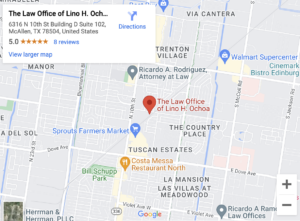
When another party causes an injury in Texas, they can be held financially liable for the damages their actions cause the victim. Damages represent the harm and loss a victim experiences. They include financial losses (economic damages) and pain & suffering (non-economic damages).
It is almost impossible to accurately price someone’s pain and suffering after an accident or personal injury. Nonetheless, an approximation must be made for you to recover compensation. Therefore, it helps to understand what is included in pain and suffering damages and how you can increase the value of your claim with help from a McAllen personal injury lawyer.
What Are Pain and Suffering Damages in a Texas Personal Injury Case?

Pain and suffering damages represent the trauma, distress, and discomfort you experience because of an accident or injury. They are collectively often referred to as non-economic damages. Examples of pain and suffering damages include:
- Physical discomfort and pain
- Impairments and disabilities
- Emotional distress
- Scarring and disfigurement
- Loss of enjoyment of life
- Mental anguish
- PTSD, anxiety, and other psychological injuries
- Diminished quality of life
Before recovering compensation for pain and suffering, you must prove the other party caused your injuries. Then, you must prove you sustained damages and establish how much those damages are worth. Placing a price on your pain and suffering is one of the most difficult steps in the personal injury claims process.
How Much Are My Pain and Suffering Damages Worth in a McAllen Personal Injury Case?
Everyone’s experience after an accident or personal injury is unique. No two people experience the same pain and suffering. Also, pain and suffering is subjective. Therefore, it is difficult to determine how much a person suffers.
Texas does not have a standard formula for calculating pain and suffering damages. However, the multiplier method is used in many cases. We begin by choosing a multiplier between 1.5 and 5. We calculate pain and suffering by multiplying the economic damages by the multiplier.
Generally, a multiplier increases as the severity of a victim’s injuries increases. We examine the factors in the case to determine the multiplier. Factors include, but are not limited to:
- The injuries you sustained
- The duration of your recovery period
- The medical treatments you received
- Your ability to care for your basic needs, such as bathing, dressing, grooming, and more
- The severity of scarring and disfigurement
- Whether you sustained long-term disability or impairment
- The type and severity of any impairment or disability
- How your injuries impact your ability to have children and/or care for your family
- Your ability to return to work and the activities you enjoyed before the accident
- How the injuries impact your quality of life
- The psychological injuries you developed because of the injuries and accident
- How your injuries impact your relationship with family and friends
Sometimes, the parties or jurors may assign a per diem to determine the value of pain and suffering damages. A per diem is a daily rate for non-economic damages.
The per diem amount may be based on the same factors used to determine the multiplier for the other method of calculating pain and suffering damages. Per diems are more suited to cases where the victim fully recovers. The value is based on the number of days between the injury date and the date the victim is released from medical care.
How Do You Prove Pain and Suffering Damages for a Personal Injury Settlement or Verdict in McAllen, TX?
Because pain and suffering damages are subjective, the insurance company will try to undervalue them. It will claim that you are exaggerating your injuries and losses to increase the value of non-economic damages.
As the victim, you have the burden of proof in a personal injury case. The evidence we use to prove pain and suffering damages includes, but is not limited to:
- Medical records
- Photographs of your injuries
- Opinions from medical specialists and other expert witnesses
- Your testimony regarding your injuries and recovery
- Notes and statements from your physicians, therapists, and counselors
- Testimony from friends and family members
You can help prove pain and suffering by keeping a journal during your recovery. Your journal should include details about your recovery, such as your emotional state and pain levels. You should also include notes about activities and tasks you cannot perform because of your injuries.
The more details you include, the better an insurance adjuster or jury can understand the level of suffering you experienced.
How Does Texas Contributory Fault Laws Impact Pain and Suffering Damages?
Texas does not impose a strict “contributory negligence” standard that would bar you from receiving compensation if you are partially to blame for your injuries. Instead, the proportionate responsibility law creates a “modified comparative negligence” standard for damages.
If you are more than 50% at fault for the cause of your injuries, you are barred from receiving any money for your claim. If your level of fault is less than 51 percent, you could receive some money for damages.
The amount you receive for damages is reduced by your level of fault for causing the accident. As a result, if you are 10% to blame for a car accident, a judge reduces your damages award by that amount.
What Is the Statute of Limitations for Pain and Suffering Damages in Texas?
Your claim for pain and suffering is included in your personal injury claim. Therefore, the deadline to file for pain and suffering damages is the same as the statute of limitations for a personal injury claim.
Most personal injury lawsuits are subject to a two-year statute of limitations in Texas. However, some exceptions, such as cases involving government entities, can shorten the deadline. Some exceptions to the statute of limitations can lengthen the time to file a claim, including the victim’s age and whether the at-fault party flees the state.
Because time is limited and the facts of your case could modify the deadline in your case, we encourage you to seek legal advice as soon as possible. Our attorneys can analyze the facts of your case to determine your filing deadline.
Get Legal Help From a McAllen Personal Injury Lawyer
Calculating the value of pain and suffering damages is challenging. The insurance company will try to undervalue these damages. Our McAllen personal injury attorneys of The Law Office of Lino H. Ochoa fight for a fair settlement for all damages. Call us today at (956) 815-0055to schedule a free consultation with an experienced lawyer.

